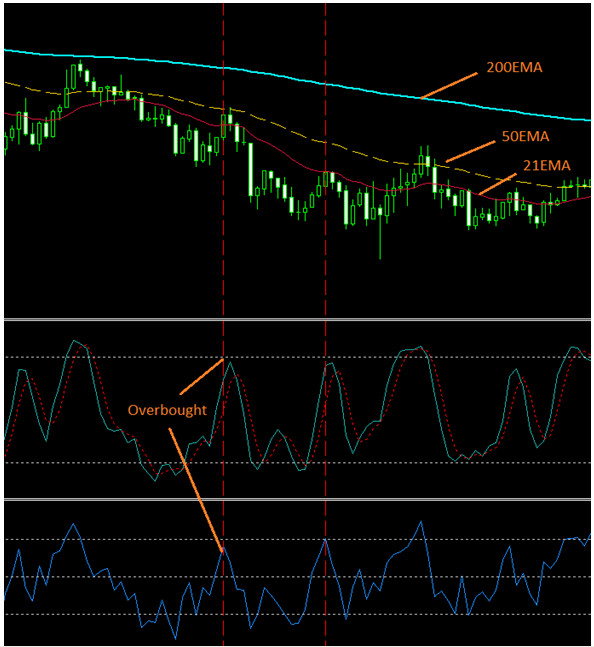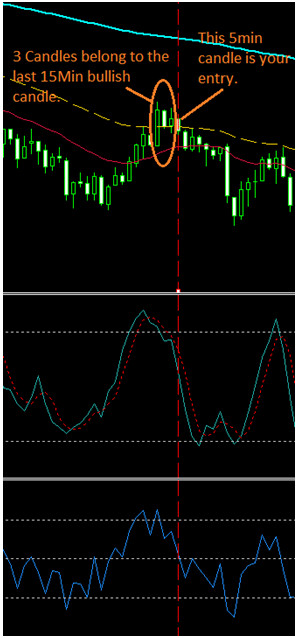HomeMade Strategies – Okane 15-30 Minute Strategy, Simple and Profitable
When I first attempted to create my own strategy my goal was to develop a system that could eliminate doubts and indecision out of the equation. I needed confirmation, a solid strategy with simple rules that could be followed and traded mechanically. Today, with months of training, I have the skills to fully benefit from the great trading opportunities it offers. If you are a newbie, you can follow the rules and trade this strategy mechanically until you acquire the skills necessary to understand the reasons behind the rules. Once you’ve reached that state you will also be able to take complete advantage of my strategy. Hence I can recommend this strategy to both newbies and more experienced traders!
Okane’s 15-30 Minute Strategy MT4 Setup
Downloads available at the bottom of the page
1. Add 3 exponential moving averages with the following periods:
200 and 50. 21 is helpful but it’s optional.
2. Add (5, 3, 3) Stochastic Oscillator with the following levels: 80 and 20.
3. Add RSI with value 4 and the following levels: 75 and 25.
4. Add FiboPiv_v2
Few words about the FiboPiv:
This is an indicator that calculates and draws S/R-lines on your chart. The accuracy of these lines are very high. I advise newbie traders to not trade near these lines until they understand price action well, specially the pivot-line. Sometimes price is in indecision around the pivot-line, which means you can’t identify a clear trend. After you understand how price reacts near important S/R-lines you can use them to your advantage. You can learn about the PivotCalc here.
How does this Strategy Work?
First you need to confirm the direction of the trend. The moving averages are the very useful tools for this task. To identify a trend go to the 15-minute chart and see if the candlesticks are under or above the 200-EMA AND the 50-EMA. To make sure the trend is not in a state of consolidation or about to change direction it’s important to identify previous highs and lows. To locate these highs and lows simply mark the areas where stochastic oscillator showed overbought/oversold levels. Check to see if price is stepping down and is under the 200 and 50-EMA, if that is the case look for lower highs and lower lows. If price is stepping up it should be creating higher highs and higher lows above the 200 and 50-EMA. The goal is to find these “steps” or small retracements inside the trend.
-For Call options: enter at higher lows, candlesticks should be above the 200 and 50-EMA and oversold levels on both Stochastic and RSI
-For Put options: enter at lower highs, candlesticks should be under the 200 and 50-EMA and overbought levels on both Stochastic and RIS
Here is an example of a 15-minute chart of USD/JPY:

The two vertical red lines show the lower highs at overbought areas on the 15-minute chart. Notice that these two highs are also under the 200 and the 50EMA. These are good locations for Put-Options.
You can actually find two more Put opportunities if you look carefully. Notice that the distance between the 50 and 21-EMA is becoming narrower on the right side in the picture and Doji-candles are forming. This is not a good place for Put-options even though Stochastic and RSI are overbought.
How to pick an entry after you have confirmed the trend direction?
Depending on whether you are a newbie or an experienced trader the approach differs.
Method 1:
First approach is for the newbies who want to trade this mechanically until they become skilled. In the example above let’s pretend you are just seeing the candles form a lower high, look at the second vertical red line from left. Stochastic and RSI are about to touch overbought levels. You must let the current bullish 15-minute candle to finish and confirm that the retracement is over. In order to confirm the bullish move is over, change to the 5-minute chart and see if a 5-minute bearish candle forms.
Example of a Put Option in a downtrend
In this picture the charts are showing the same currency pair as in the picture above, USD/JPY. But this time you are looking at the 5-minute timeframe. Notice how the candles are closing lower and lower (in circle). This indicates that the high is likely to be over. Pay attention to the overbought areas too. The Stochastic and the RSI are now crossing the overbought levels and are heading down. The entry is after this 5-minute bearish candle is closed. Depending on the market volatility choose between 15-minute or 30-minute expiry.

Method 2:
This approach can be applied by advanced an experienced traders who have basic candlestick knowledge, you know how to use price action, you are good at drawing S/R-lines and you understand volatility. So, instead of waiting for a 5-minute bearish candle to form you can get more precise entries by switching to the 1-minute time frame and drawing S/R-lines. Remember though, the M15 and the M5 still have to be overbought!
Here is a picture of the 1-minute chart of the same currency pair in the pictures above:

Notice how price resisted at the second golden line from bottom to top. Notice the pin-bars indicating price was forced down. Your entry here would’ve been earlier than in method 1, meaning you entered at a higher price. So basically, using price action, there is no need to wait for a full 5-minute candle to finish in the direction you want to trade. Price failing to continue up confirmed the retracement was over and thus gave you a better entry.
You can apply the same methods on Call Options, just look for higher highs and higher lows as I mentioned earlier.
Why does this strategy suck?
Not so surprisingly, this strategy does not work in ANY market condition. But then again, I don’t know any strategy that does. The main issue is being able to patiently wait for all of the correct market conditions to line up for you. This could take a while, some days you can’t trade anything because market is simply not “stepping” in any direction but rather jumps volatilely between different support and resistance areas. Furthermore, it can be quite difficult for beginners to find the best entries.
Why this Strategy doesn’t suck?
This strategy provides with enough confirmations to induce the trader to take a trade. During the time I’ve tested this strategy it has proven to be pretty accurate. The rules are simple to follow. This strategy also teaches you trend identification and lets you practice on your price action skills!
Conclusion – Check out Okane’s Diary to Learn More!
Whether this strategy sucks or not depends entirely on how well you understand the reasons behind the rules of this strategy. Try it out on a demo account first. You can benefit from my trading diary and the forum thread I started about this strategy. Some of your questions might have been answered already in these threads!
Downloads Available:
- Okane 15-30 Mins Strategy Set-Up download
- FiboPV indicator to download